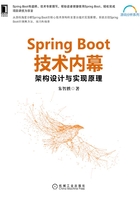
上QQ阅读APP看书,第一时间看更新
4.1 run方法核心流程
在分析和学习整个run方法的源代码及操作之前,我们先通过图4-1所示的流程图来看一下SpringApplication调用的run方法处理的核心操作都包含哪些。然后,后面的章节我们再逐步细化分析每个过程中的源代码实现。

图4-1 run方法核心运行流程图
上面的流程图可以看出,SpringApplication在run方法中重点做了以下操作。
·获取监听器和参数配置。
·打印Banner信息。
·创建并初始化容器。
·监听器发送通知。
当然,除了核心操作,run方法运行过程中还涉及启动时长统计、异常报告、启动日志、异常处理等辅助操作。
对照流程图,我们再来整体看一下入口run方法的源代码,核心部分的功能已通过注释的形式进行说明。
public ConfigurableApplicationContext run(String... args) {
// 创建StopWatch对象,用于统计run方法启动时长
StopWatch stopWatch = new StopWatch();
// 启动统计
stopWatch.start();
ConfigurableApplicationContext context = null;
Collection<SpringBootExceptionReporter> exceptionReporters = new ArrayList<>();
// 配置headless 属性
configureHeadlessProperty();
// 获得SpringApplicationRunListener 数组
// 该数组封装于SpringApplicationRunListeners对象的listeners中
SpringApplicationRunListeners listeners = getRunListeners(args);
// 启动监听,遍历SpringApplicationRunListener数组每个元素,并执行
listeners.starting();
try {
// 创建ApplicationArguments对象
ApplicationArguments applicationArguments = new DefaultApplicationArguments(
args);
// 加载属性配置,包括所有的配置属性(如:application.properties中和外部的属性配置)
ConfigurableEnvironment environment = prepareEnvironment(listeners,
applicationArguments);
configureIgnoreBeanInfo(environment);
// 打印Banner
Banner printedBanner = printBanner(environment);
// 创建容器
context = createApplicationContext();
// 异常报告器
exceptionReporters = getSpringFactoriesInstances(
SpringBootExceptionReporter.class,
new Class[] { ConfigurableApplicationContext.class }, context);
// 准备容器,组件对象之间进行关联
prepareContext(context, environment, listeners, applicationArguments, printedBanner);
// 初始化容器
refreshContext(context);
// 初始化操作之后执行,默认实现为空
afterRefresh(context, applicationArguments);
// 停止时长统计
stopWatch.stop();
// 打印启动日志
if (this.logStartupInfo) {
new StartupInfoLogger(this.mainApplicationClass)
.logStarted(getApplicationLog(), stopWatch);
}
// 通知监听器:容器启动完成
listeners.started(context);
// 调用ApplicationRunner和CommandLineRunner的运行方法。
callRunners(context, applicationArguments);
} catch (Throwable ex) {
// 异常处理
handleRunFailure(context, ex, exceptionReporters, listeners);
throw new IllegalStateException(ex);
}
try {
// 通知监听器:容器正在运行
listeners.running(context);
} catch (Throwable ex) {
// 异常处理
handleRunFailure(context, ex, exceptionReporters, null);
throw new IllegalStateException(ex);
}
return context;
}
在整体了解了整个run方法运行流程及核心代码后,下面我们针对具体的过程进行讲解。